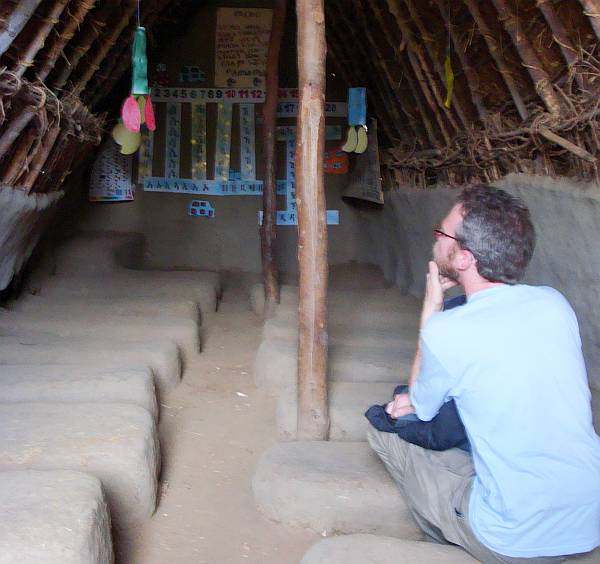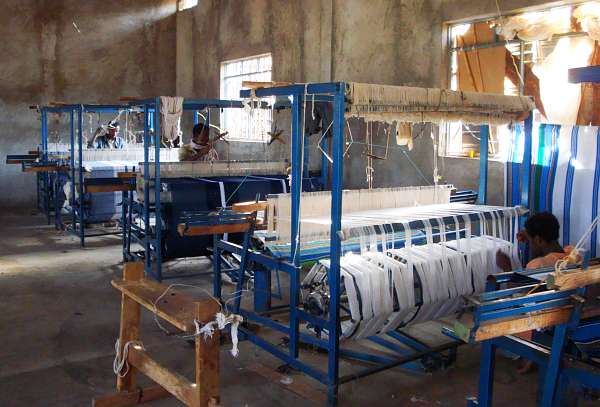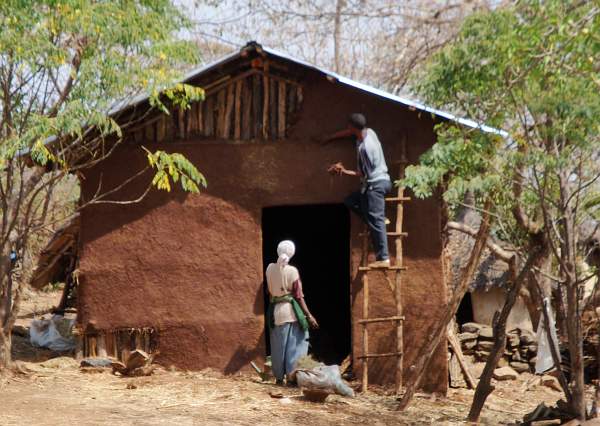Gonder To Bahir Dar - A Ramble
After Gonder we stuck our toes in the water of the Lalibela road by taking the turn-off at Werota. We expected to find a gravel road under major repairs but found new tarmac instead, and learned that it extends about two-thirds of the way.
Roadside scenes on the way to the village of Werota
So we went five miles as planned and then took the 2km track for the Awramba weaving cooperative. That was a track and a half - rocks large and small, stones, ruts and high ridges, and plenty of waving children. Quite a test for our fully-laden bikes, about nine litres of additional water on mine at the time.
The track to Awramba, pictured as we departed.
The co-op is a self-contained village of over a hundred homes, over four hundred people, surviving on the sale of an extensive range of clothes and textiles woven on site. There is no running water yet (almost completed, funded by the government), only part-time electricity, a shop and cafeteria, and a building housing twelve guest rooms where we were welcome to stay the night. So we did.
But the commune's main feature is that it is entirely secular, founded about twenty-five years ago to demonstrate in an extensively religious country, that poverty can be eradicated by education and work and an atheistic way of life.
Income is also earned through charging vistors like us for meals and rooms. One pound for a single room, 15p to 60p for breakfast, lunch and dinner.
So it was very pleasant to spend a while there watching the weavers, being shown round the school, library and other parts of the village and watching life go on in general. Including the construction of a new home near the village centre. The buildings are all of mud on frames of tree-branches, with tin or thatch roofs.
Beau contemplates the school room.
And ponders what books to borrow from the library.
Centre of the village, cafeteria to the right behind bikes.
Start of the school day.
Grain storage vessels with thatch roofs.
Views inside the weaving shed.
Carrying water through the village.
Marshalling the donkeys in the morning for the day's work.
New mud and timber family home nearing completion.
This was all in stark contrast to the next couple of days.
We decided against visiting Lalibela. Even with a lot of new tarmac it would have been a total of six days for us, and the main access for tourists now is by air to the relatively new landing strip. Yet it is a functioning Orthodox centre of worship full of churches with a large population of priests and monks. Largely isolated from the rest of the country until relatively recently, we read that it is besieged now by tourists brought in by air and tarmac and "must see" phrases in the guide books. So the question arises as it often does on a journey of this sort: Do we want to be a part of that?
We continued on to Bahir Dar on Lake Tana instead, after leaving Awramba.
There are a number of islands scattered around the lake housing isolated Orthodox monasteries, and a selection of organised excursions from Bahir Dar for tourists to see/besiege them.
One of which we took.
The first stop on our little boat with six passengers was a tiny island with tiny monastic community and museum, the entrance fee for which I could not help but notice was double the cost to live for a whole day (and night) at the weaving commune.
Another boat with a dozen passengers arrived so we all squeezed in to the compact museum where we were proudly shown the island's prize exhibit, a large 700-year-old manuscript prayer book. The curator enthusiastically thumbed through it to show each of us the elaborate illustrations inside, pages visibly loosening as he flicked them. And I wondered, after its 700 years of 'normal use', how much more of that sort of treatment would be meted out for the benefit of paying tourists before the community's prized relic disintegrates in front of an array of clicking cameras.
Ah well! Onwards and upwards.
A low-flying military jet screamed overhead towards some distant shore, the noise tearing around the lake's surface unimpeded by trees or hills.
We moored at a second island where the monastery seemed to be closed but there was still a charge to see a 'museum' which we declined.
Three or four more military jets screamed and roared around above the lake's waters as we chugged towards a third island and another Orthodox community. Our route took us close to a flotilla of papyrus kayaks, a common form of transport for those living and working on the lake. This convoy was carrying firewood between lakeshore and islands, each kayak paddled by two oarsmen.
A couple more jets roared around - I remembered that there are national elections here in eight weeks.
My head was starting to fill with those 'follow the money' questions:
How did this country pay for those planes?
Where did the money come from, what did the people of this country pay?
Where did that money go? (UK? I don't know. US? Maybe neither of the above - it doesn't matter)
To whom in that country(s) did all that money go?
How much to the politicians of that country?
How much finds its way back to the politicians of the purchasing country?
- You get the idea - maybe. Maybe not.
Then, from the helmsman of our boat, "It's a seven-hour journey for these papyrus boats, to deliver the firewood to the island."
Followed by one of those 'moments of truth', piercing the stark contrast between papyrus boats on the water and wailing jets above, a question from a fellow passenger: "Do they paddle all the way back the same day or stay overnight?" "Do they return on the same boat?"
Somehow, the thought of the boatmen returning in the comfort of one of the military jets entered my head - they had after all helped to buy them from the people of some 'western' country. I knew that the 'moment of truth' was complete. The truth was, I had inadvertently boarded completely the wrong boat in Bahir Dar.
How did that happen?
But there was no way back, as we arrived at the jetty of the largest religious community of our tour. And being the largest, the fee for the guide to show us the monastic buildings and relics was now three times the cost of living for one day at the weaving cooperative. So I declined their offer and waited for our final stop-off at a lakeside tea and fruit stall, enabling things to get back into perspective.
Colourful red bird outside the final monastery.
Schoolgirl arrives home by papyrus kayak at the tea and fruit kiosk.
Children at the lakeside tea stall bring things back into perspective.
So maybe I'll steer my handlebars clear of politics for now and stick to the highways and byways on my map - if I haven't yet given it away.























